Employability Skills Analysis: A Case Study Report on Tesco
VerifiedAdded on 2020/01/07
|13
|4614
|143
Report
AI Summary
This report presents a comprehensive case study on Tesco, focusing on employability skills within the organization. It begins by examining the development of personal performance objectives and responsibilities, evaluating their effectiveness, and suggesting improvements, including the application of motivation techniques. The report then identifies a work-based problem at Tesco, exploring communication styles and time management strategies for effective resolution. Furthermore, it analyzes team roles, dynamics, and collaborative efforts for goal achievement, suggesting alternative methods for task completion. Finally, the report discusses tools and methods for problem resolution, strategy development, and the evaluation of strategy implementation, providing a holistic view of employability skills in a real-world business context.

Employability Skills
A case study of Tesco
A case study of Tesco
Paraphrase This Document
Need a fresh take? Get an instant paraphrase of this document with our AI Paraphraser
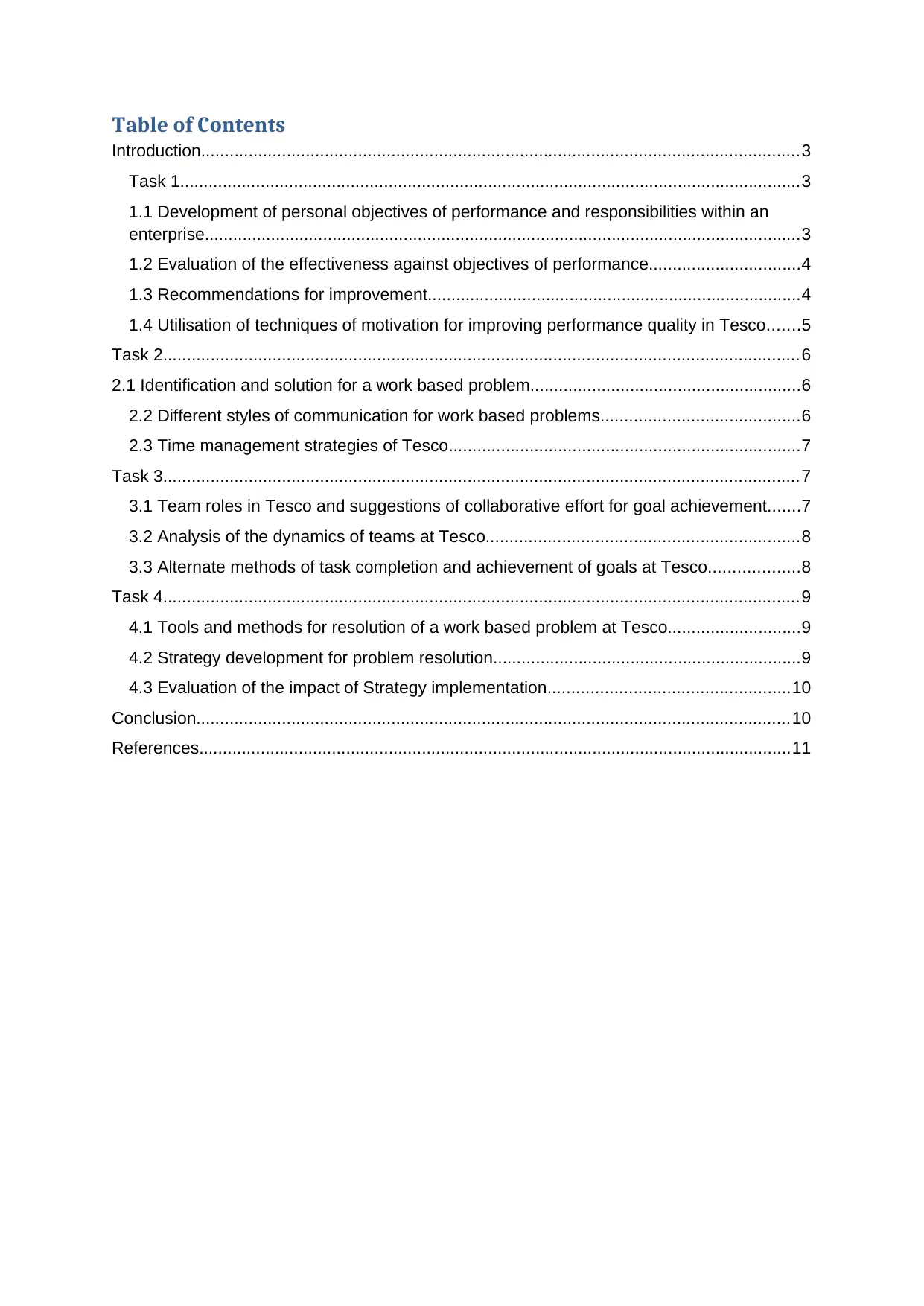
Table of Contents
Introduction..............................................................................................................................3
Task 1...................................................................................................................................3
1.1 Development of personal objectives of performance and responsibilities within an
enterprise..............................................................................................................................3
1.2 Evaluation of the effectiveness against objectives of performance................................4
1.3 Recommendations for improvement...............................................................................4
1.4 Utilisation of techniques of motivation for improving performance quality in Tesco.......5
Task 2......................................................................................................................................6
2.1 Identification and solution for a work based problem.........................................................6
2.2 Different styles of communication for work based problems..........................................6
2.3 Time management strategies of Tesco..........................................................................7
Task 3......................................................................................................................................7
3.1 Team roles in Tesco and suggestions of collaborative effort for goal achievement.......7
3.2 Analysis of the dynamics of teams at Tesco..................................................................8
3.3 Alternate methods of task completion and achievement of goals at Tesco...................8
Task 4......................................................................................................................................9
4.1 Tools and methods for resolution of a work based problem at Tesco............................9
4.2 Strategy development for problem resolution.................................................................9
4.3 Evaluation of the impact of Strategy implementation...................................................10
Conclusion.............................................................................................................................10
References.............................................................................................................................11
Introduction..............................................................................................................................3
Task 1...................................................................................................................................3
1.1 Development of personal objectives of performance and responsibilities within an
enterprise..............................................................................................................................3
1.2 Evaluation of the effectiveness against objectives of performance................................4
1.3 Recommendations for improvement...............................................................................4
1.4 Utilisation of techniques of motivation for improving performance quality in Tesco.......5
Task 2......................................................................................................................................6
2.1 Identification and solution for a work based problem.........................................................6
2.2 Different styles of communication for work based problems..........................................6
2.3 Time management strategies of Tesco..........................................................................7
Task 3......................................................................................................................................7
3.1 Team roles in Tesco and suggestions of collaborative effort for goal achievement.......7
3.2 Analysis of the dynamics of teams at Tesco..................................................................8
3.3 Alternate methods of task completion and achievement of goals at Tesco...................8
Task 4......................................................................................................................................9
4.1 Tools and methods for resolution of a work based problem at Tesco............................9
4.2 Strategy development for problem resolution.................................................................9
4.3 Evaluation of the impact of Strategy implementation...................................................10
Conclusion.............................................................................................................................10
References.............................................................................................................................11
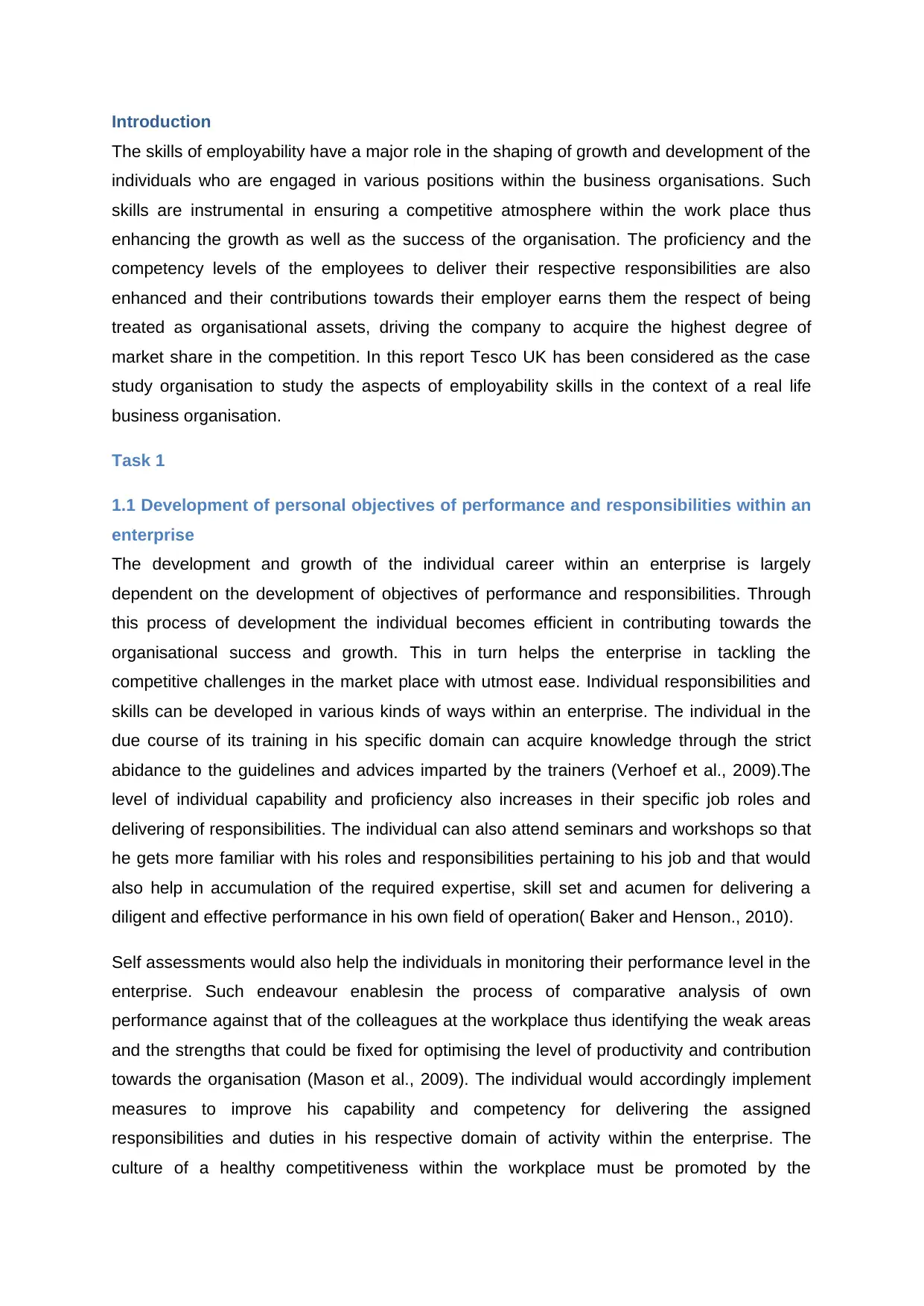
Introduction
The skills of employability have a major role in the shaping of growth and development of the
individuals who are engaged in various positions within the business organisations. Such
skills are instrumental in ensuring a competitive atmosphere within the work place thus
enhancing the growth as well as the success of the organisation. The proficiency and the
competency levels of the employees to deliver their respective responsibilities are also
enhanced and their contributions towards their employer earns them the respect of being
treated as organisational assets, driving the company to acquire the highest degree of
market share in the competition. In this report Tesco UK has been considered as the case
study organisation to study the aspects of employability skills in the context of a real life
business organisation.
Task 1
1.1 Development of personal objectives of performance and responsibilities within an
enterprise
The development and growth of the individual career within an enterprise is largely
dependent on the development of objectives of performance and responsibilities. Through
this process of development the individual becomes efficient in contributing towards the
organisational success and growth. This in turn helps the enterprise in tackling the
competitive challenges in the market place with utmost ease. Individual responsibilities and
skills can be developed in various kinds of ways within an enterprise. The individual in the
due course of its training in his specific domain can acquire knowledge through the strict
abidance to the guidelines and advices imparted by the trainers (Verhoef et al., 2009).The
level of individual capability and proficiency also increases in their specific job roles and
delivering of responsibilities. The individual can also attend seminars and workshops so that
he gets more familiar with his roles and responsibilities pertaining to his job and that would
also help in accumulation of the required expertise, skill set and acumen for delivering a
diligent and effective performance in his own field of operation( Baker and Henson., 2010).
Self assessments would also help the individuals in monitoring their performance level in the
enterprise. Such endeavour enablesin the process of comparative analysis of own
performance against that of the colleagues at the workplace thus identifying the weak areas
and the strengths that could be fixed for optimising the level of productivity and contribution
towards the organisation (Mason et al., 2009). The individual would accordingly implement
measures to improve his capability and competency for delivering the assigned
responsibilities and duties in his respective domain of activity within the enterprise. The
culture of a healthy competitiveness within the workplace must be promoted by the
The skills of employability have a major role in the shaping of growth and development of the
individuals who are engaged in various positions within the business organisations. Such
skills are instrumental in ensuring a competitive atmosphere within the work place thus
enhancing the growth as well as the success of the organisation. The proficiency and the
competency levels of the employees to deliver their respective responsibilities are also
enhanced and their contributions towards their employer earns them the respect of being
treated as organisational assets, driving the company to acquire the highest degree of
market share in the competition. In this report Tesco UK has been considered as the case
study organisation to study the aspects of employability skills in the context of a real life
business organisation.
Task 1
1.1 Development of personal objectives of performance and responsibilities within an
enterprise
The development and growth of the individual career within an enterprise is largely
dependent on the development of objectives of performance and responsibilities. Through
this process of development the individual becomes efficient in contributing towards the
organisational success and growth. This in turn helps the enterprise in tackling the
competitive challenges in the market place with utmost ease. Individual responsibilities and
skills can be developed in various kinds of ways within an enterprise. The individual in the
due course of its training in his specific domain can acquire knowledge through the strict
abidance to the guidelines and advices imparted by the trainers (Verhoef et al., 2009).The
level of individual capability and proficiency also increases in their specific job roles and
delivering of responsibilities. The individual can also attend seminars and workshops so that
he gets more familiar with his roles and responsibilities pertaining to his job and that would
also help in accumulation of the required expertise, skill set and acumen for delivering a
diligent and effective performance in his own field of operation( Baker and Henson., 2010).
Self assessments would also help the individuals in monitoring their performance level in the
enterprise. Such endeavour enablesin the process of comparative analysis of own
performance against that of the colleagues at the workplace thus identifying the weak areas
and the strengths that could be fixed for optimising the level of productivity and contribution
towards the organisation (Mason et al., 2009). The individual would accordingly implement
measures to improve his capability and competency for delivering the assigned
responsibilities and duties in his respective domain of activity within the enterprise. The
culture of a healthy competitiveness within the workplace must be promoted by the
⊘ This is a preview!⊘
Do you want full access?
Subscribe today to unlock all pages.

Trusted by 1+ million students worldwide
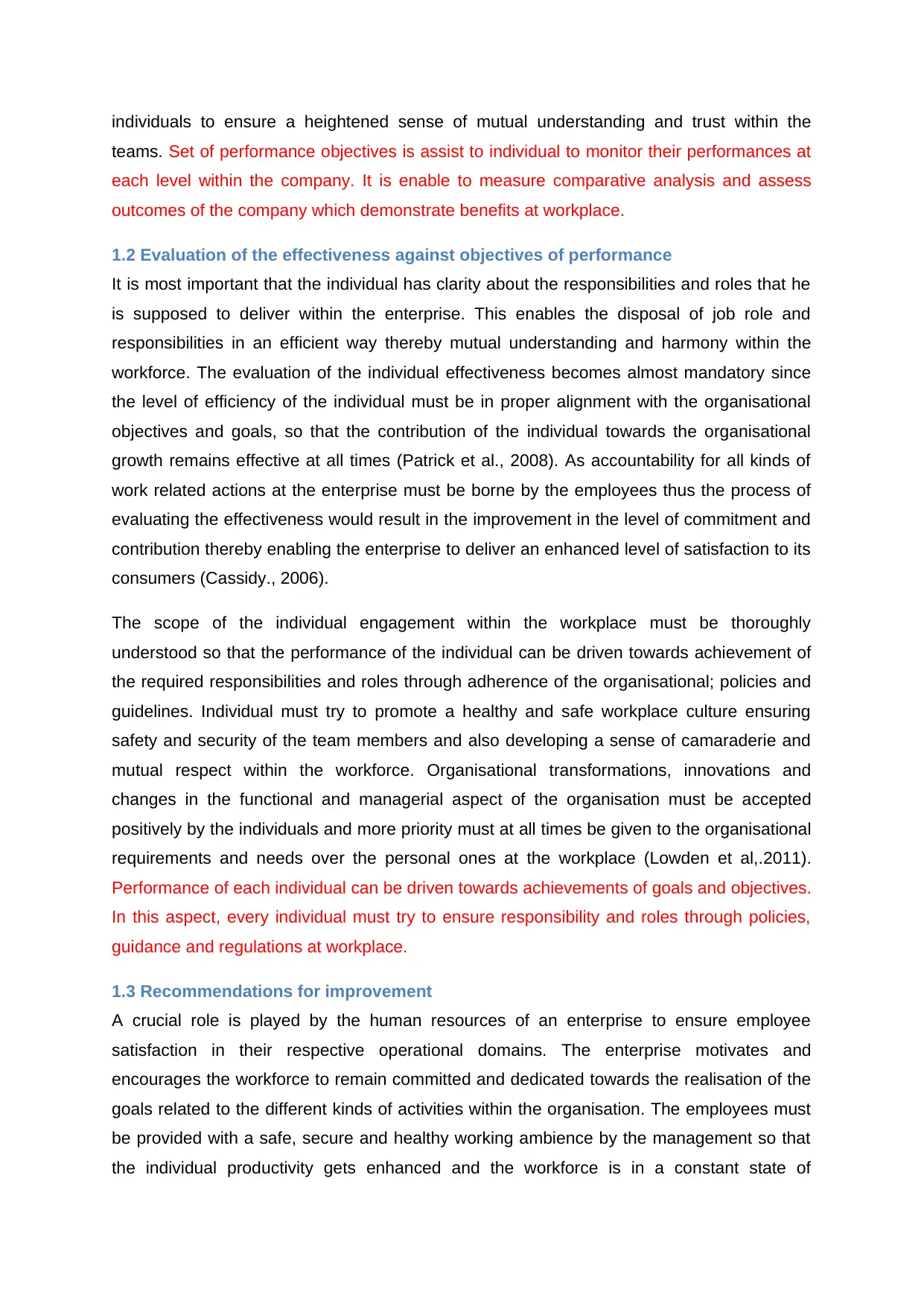
individuals to ensure a heightened sense of mutual understanding and trust within the
teams. Set of performance objectives is assist to individual to monitor their performances at
each level within the company. It is enable to measure comparative analysis and assess
outcomes of the company which demonstrate benefits at workplace.
1.2 Evaluation of the effectiveness against objectives of performance
It is most important that the individual has clarity about the responsibilities and roles that he
is supposed to deliver within the enterprise. This enables the disposal of job role and
responsibilities in an efficient way thereby mutual understanding and harmony within the
workforce. The evaluation of the individual effectiveness becomes almost mandatory since
the level of efficiency of the individual must be in proper alignment with the organisational
objectives and goals, so that the contribution of the individual towards the organisational
growth remains effective at all times (Patrick et al., 2008). As accountability for all kinds of
work related actions at the enterprise must be borne by the employees thus the process of
evaluating the effectiveness would result in the improvement in the level of commitment and
contribution thereby enabling the enterprise to deliver an enhanced level of satisfaction to its
consumers (Cassidy., 2006).
The scope of the individual engagement within the workplace must be thoroughly
understood so that the performance of the individual can be driven towards achievement of
the required responsibilities and roles through adherence of the organisational; policies and
guidelines. Individual must try to promote a healthy and safe workplace culture ensuring
safety and security of the team members and also developing a sense of camaraderie and
mutual respect within the workforce. Organisational transformations, innovations and
changes in the functional and managerial aspect of the organisation must be accepted
positively by the individuals and more priority must at all times be given to the organisational
requirements and needs over the personal ones at the workplace (Lowden et al,.2011).
Performance of each individual can be driven towards achievements of goals and objectives.
In this aspect, every individual must try to ensure responsibility and roles through policies,
guidance and regulations at workplace.
1.3 Recommendations for improvement
A crucial role is played by the human resources of an enterprise to ensure employee
satisfaction in their respective operational domains. The enterprise motivates and
encourages the workforce to remain committed and dedicated towards the realisation of the
goals related to the different kinds of activities within the organisation. The employees must
be provided with a safe, secure and healthy working ambience by the management so that
the individual productivity gets enhanced and the workforce is in a constant state of
teams. Set of performance objectives is assist to individual to monitor their performances at
each level within the company. It is enable to measure comparative analysis and assess
outcomes of the company which demonstrate benefits at workplace.
1.2 Evaluation of the effectiveness against objectives of performance
It is most important that the individual has clarity about the responsibilities and roles that he
is supposed to deliver within the enterprise. This enables the disposal of job role and
responsibilities in an efficient way thereby mutual understanding and harmony within the
workforce. The evaluation of the individual effectiveness becomes almost mandatory since
the level of efficiency of the individual must be in proper alignment with the organisational
objectives and goals, so that the contribution of the individual towards the organisational
growth remains effective at all times (Patrick et al., 2008). As accountability for all kinds of
work related actions at the enterprise must be borne by the employees thus the process of
evaluating the effectiveness would result in the improvement in the level of commitment and
contribution thereby enabling the enterprise to deliver an enhanced level of satisfaction to its
consumers (Cassidy., 2006).
The scope of the individual engagement within the workplace must be thoroughly
understood so that the performance of the individual can be driven towards achievement of
the required responsibilities and roles through adherence of the organisational; policies and
guidelines. Individual must try to promote a healthy and safe workplace culture ensuring
safety and security of the team members and also developing a sense of camaraderie and
mutual respect within the workforce. Organisational transformations, innovations and
changes in the functional and managerial aspect of the organisation must be accepted
positively by the individuals and more priority must at all times be given to the organisational
requirements and needs over the personal ones at the workplace (Lowden et al,.2011).
Performance of each individual can be driven towards achievements of goals and objectives.
In this aspect, every individual must try to ensure responsibility and roles through policies,
guidance and regulations at workplace.
1.3 Recommendations for improvement
A crucial role is played by the human resources of an enterprise to ensure employee
satisfaction in their respective operational domains. The enterprise motivates and
encourages the workforce to remain committed and dedicated towards the realisation of the
goals related to the different kinds of activities within the organisation. The employees must
be provided with a safe, secure and healthy working ambience by the management so that
the individual productivity gets enhanced and the workforce is in a constant state of
Paraphrase This Document
Need a fresh take? Get an instant paraphrase of this document with our AI Paraphraser
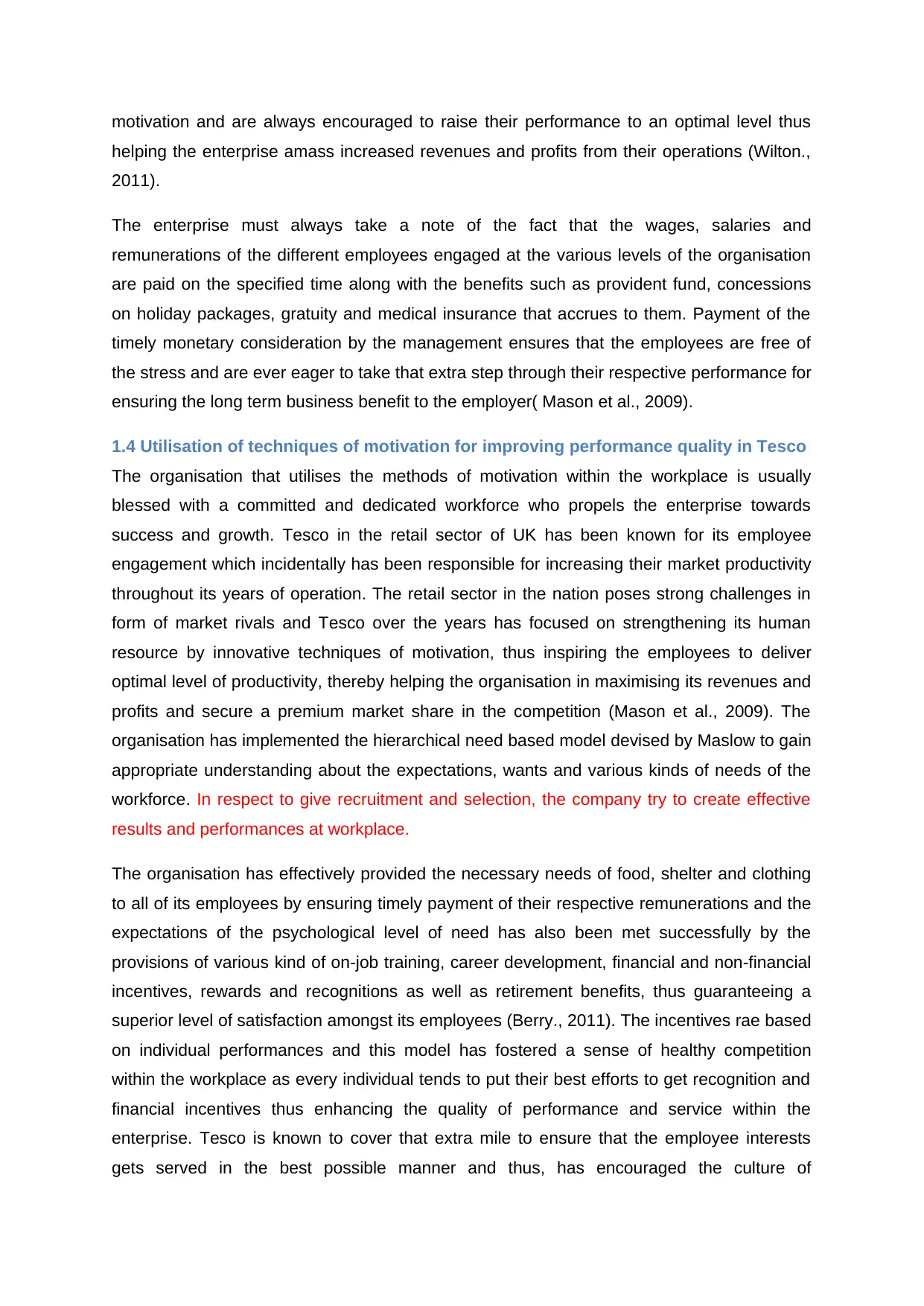
motivation and are always encouraged to raise their performance to an optimal level thus
helping the enterprise amass increased revenues and profits from their operations (Wilton.,
2011).
The enterprise must always take a note of the fact that the wages, salaries and
remunerations of the different employees engaged at the various levels of the organisation
are paid on the specified time along with the benefits such as provident fund, concessions
on holiday packages, gratuity and medical insurance that accrues to them. Payment of the
timely monetary consideration by the management ensures that the employees are free of
the stress and are ever eager to take that extra step through their respective performance for
ensuring the long term business benefit to the employer( Mason et al., 2009).
1.4 Utilisation of techniques of motivation for improving performance quality in Tesco
The organisation that utilises the methods of motivation within the workplace is usually
blessed with a committed and dedicated workforce who propels the enterprise towards
success and growth. Tesco in the retail sector of UK has been known for its employee
engagement which incidentally has been responsible for increasing their market productivity
throughout its years of operation. The retail sector in the nation poses strong challenges in
form of market rivals and Tesco over the years has focused on strengthening its human
resource by innovative techniques of motivation, thus inspiring the employees to deliver
optimal level of productivity, thereby helping the organisation in maximising its revenues and
profits and secure a premium market share in the competition (Mason et al., 2009). The
organisation has implemented the hierarchical need based model devised by Maslow to gain
appropriate understanding about the expectations, wants and various kinds of needs of the
workforce. In respect to give recruitment and selection, the company try to create effective
results and performances at workplace.
The organisation has effectively provided the necessary needs of food, shelter and clothing
to all of its employees by ensuring timely payment of their respective remunerations and the
expectations of the psychological level of need has also been met successfully by the
provisions of various kind of on-job training, career development, financial and non-financial
incentives, rewards and recognitions as well as retirement benefits, thus guaranteeing a
superior level of satisfaction amongst its employees (Berry., 2011). The incentives rae based
on individual performances and this model has fostered a sense of healthy competition
within the workplace as every individual tends to put their best efforts to get recognition and
financial incentives thus enhancing the quality of performance and service within the
enterprise. Tesco is known to cover that extra mile to ensure that the employee interests
gets served in the best possible manner and thus, has encouraged the culture of
helping the enterprise amass increased revenues and profits from their operations (Wilton.,
2011).
The enterprise must always take a note of the fact that the wages, salaries and
remunerations of the different employees engaged at the various levels of the organisation
are paid on the specified time along with the benefits such as provident fund, concessions
on holiday packages, gratuity and medical insurance that accrues to them. Payment of the
timely monetary consideration by the management ensures that the employees are free of
the stress and are ever eager to take that extra step through their respective performance for
ensuring the long term business benefit to the employer( Mason et al., 2009).
1.4 Utilisation of techniques of motivation for improving performance quality in Tesco
The organisation that utilises the methods of motivation within the workplace is usually
blessed with a committed and dedicated workforce who propels the enterprise towards
success and growth. Tesco in the retail sector of UK has been known for its employee
engagement which incidentally has been responsible for increasing their market productivity
throughout its years of operation. The retail sector in the nation poses strong challenges in
form of market rivals and Tesco over the years has focused on strengthening its human
resource by innovative techniques of motivation, thus inspiring the employees to deliver
optimal level of productivity, thereby helping the organisation in maximising its revenues and
profits and secure a premium market share in the competition (Mason et al., 2009). The
organisation has implemented the hierarchical need based model devised by Maslow to gain
appropriate understanding about the expectations, wants and various kinds of needs of the
workforce. In respect to give recruitment and selection, the company try to create effective
results and performances at workplace.
The organisation has effectively provided the necessary needs of food, shelter and clothing
to all of its employees by ensuring timely payment of their respective remunerations and the
expectations of the psychological level of need has also been met successfully by the
provisions of various kind of on-job training, career development, financial and non-financial
incentives, rewards and recognitions as well as retirement benefits, thus guaranteeing a
superior level of satisfaction amongst its employees (Berry., 2011). The incentives rae based
on individual performances and this model has fostered a sense of healthy competition
within the workplace as every individual tends to put their best efforts to get recognition and
financial incentives thus enhancing the quality of performance and service within the
enterprise. Tesco is known to cover that extra mile to ensure that the employee interests
gets served in the best possible manner and thus, has encouraged the culture of
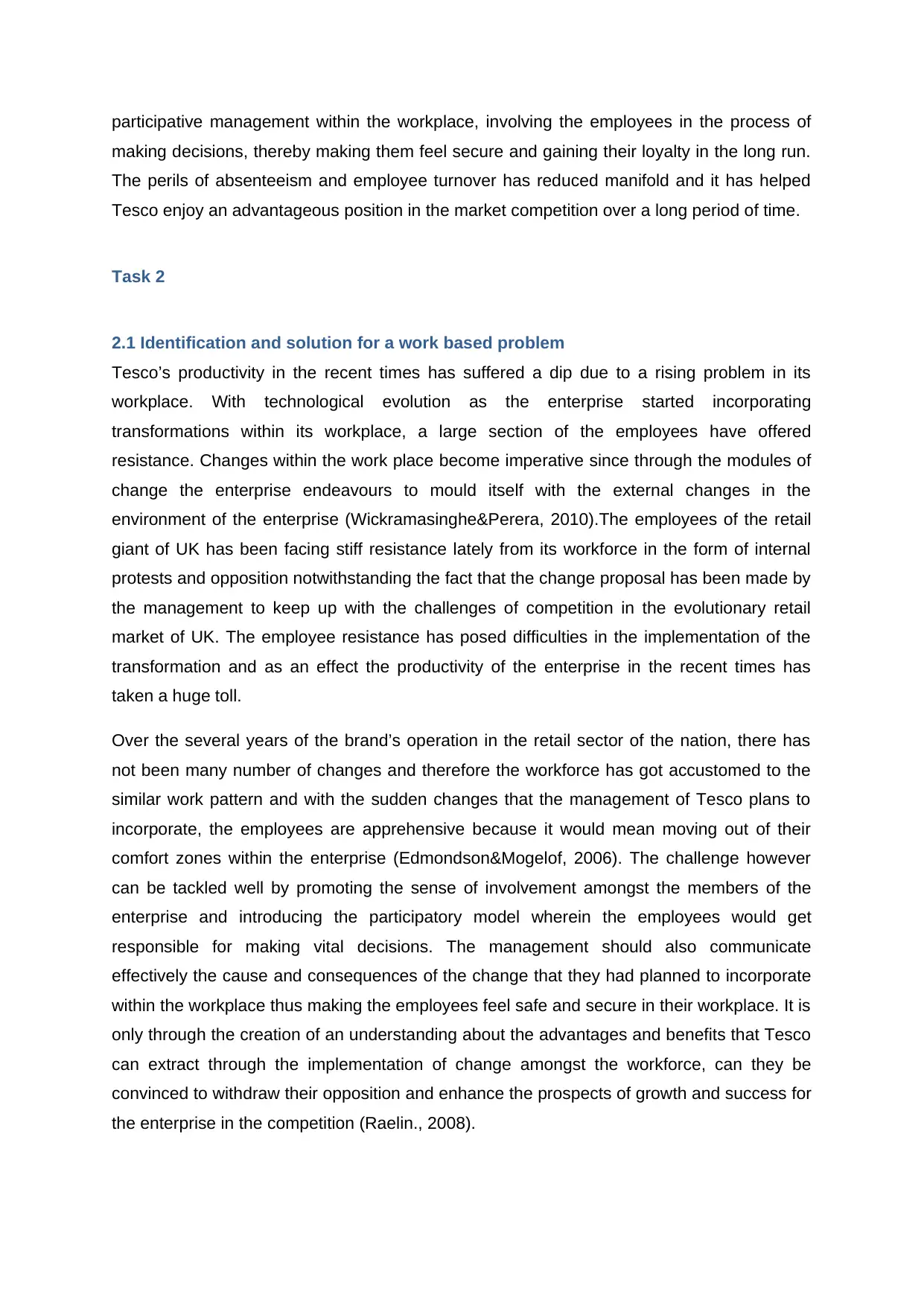
participative management within the workplace, involving the employees in the process of
making decisions, thereby making them feel secure and gaining their loyalty in the long run.
The perils of absenteeism and employee turnover has reduced manifold and it has helped
Tesco enjoy an advantageous position in the market competition over a long period of time.
Task 2
2.1 Identification and solution for a work based problem
Tesco’s productivity in the recent times has suffered a dip due to a rising problem in its
workplace. With technological evolution as the enterprise started incorporating
transformations within its workplace, a large section of the employees have offered
resistance. Changes within the work place become imperative since through the modules of
change the enterprise endeavours to mould itself with the external changes in the
environment of the enterprise (Wickramasinghe&Perera, 2010).The employees of the retail
giant of UK has been facing stiff resistance lately from its workforce in the form of internal
protests and opposition notwithstanding the fact that the change proposal has been made by
the management to keep up with the challenges of competition in the evolutionary retail
market of UK. The employee resistance has posed difficulties in the implementation of the
transformation and as an effect the productivity of the enterprise in the recent times has
taken a huge toll.
Over the several years of the brand’s operation in the retail sector of the nation, there has
not been many number of changes and therefore the workforce has got accustomed to the
similar work pattern and with the sudden changes that the management of Tesco plans to
incorporate, the employees are apprehensive because it would mean moving out of their
comfort zones within the enterprise (Edmondson&Mogelof, 2006). The challenge however
can be tackled well by promoting the sense of involvement amongst the members of the
enterprise and introducing the participatory model wherein the employees would get
responsible for making vital decisions. The management should also communicate
effectively the cause and consequences of the change that they had planned to incorporate
within the workplace thus making the employees feel safe and secure in their workplace. It is
only through the creation of an understanding about the advantages and benefits that Tesco
can extract through the implementation of change amongst the workforce, can they be
convinced to withdraw their opposition and enhance the prospects of growth and success for
the enterprise in the competition (Raelin., 2008).
making decisions, thereby making them feel secure and gaining their loyalty in the long run.
The perils of absenteeism and employee turnover has reduced manifold and it has helped
Tesco enjoy an advantageous position in the market competition over a long period of time.
Task 2
2.1 Identification and solution for a work based problem
Tesco’s productivity in the recent times has suffered a dip due to a rising problem in its
workplace. With technological evolution as the enterprise started incorporating
transformations within its workplace, a large section of the employees have offered
resistance. Changes within the work place become imperative since through the modules of
change the enterprise endeavours to mould itself with the external changes in the
environment of the enterprise (Wickramasinghe&Perera, 2010).The employees of the retail
giant of UK has been facing stiff resistance lately from its workforce in the form of internal
protests and opposition notwithstanding the fact that the change proposal has been made by
the management to keep up with the challenges of competition in the evolutionary retail
market of UK. The employee resistance has posed difficulties in the implementation of the
transformation and as an effect the productivity of the enterprise in the recent times has
taken a huge toll.
Over the several years of the brand’s operation in the retail sector of the nation, there has
not been many number of changes and therefore the workforce has got accustomed to the
similar work pattern and with the sudden changes that the management of Tesco plans to
incorporate, the employees are apprehensive because it would mean moving out of their
comfort zones within the enterprise (Edmondson&Mogelof, 2006). The challenge however
can be tackled well by promoting the sense of involvement amongst the members of the
enterprise and introducing the participatory model wherein the employees would get
responsible for making vital decisions. The management should also communicate
effectively the cause and consequences of the change that they had planned to incorporate
within the workplace thus making the employees feel safe and secure in their workplace. It is
only through the creation of an understanding about the advantages and benefits that Tesco
can extract through the implementation of change amongst the workforce, can they be
convinced to withdraw their opposition and enhance the prospects of growth and success for
the enterprise in the competition (Raelin., 2008).
⊘ This is a preview!⊘
Do you want full access?
Subscribe today to unlock all pages.

Trusted by 1+ million students worldwide
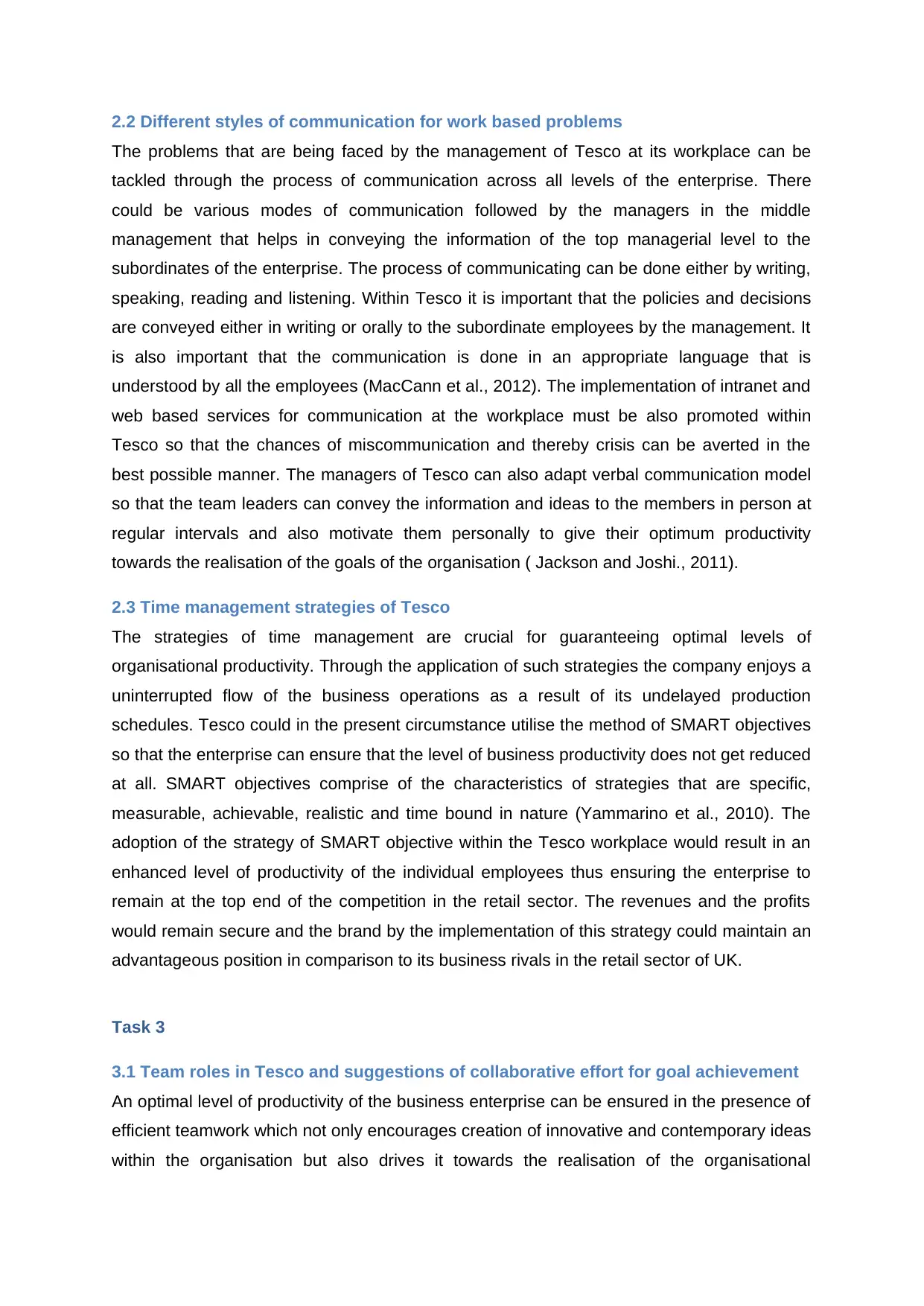
2.2 Different styles of communication for work based problems
The problems that are being faced by the management of Tesco at its workplace can be
tackled through the process of communication across all levels of the enterprise. There
could be various modes of communication followed by the managers in the middle
management that helps in conveying the information of the top managerial level to the
subordinates of the enterprise. The process of communicating can be done either by writing,
speaking, reading and listening. Within Tesco it is important that the policies and decisions
are conveyed either in writing or orally to the subordinate employees by the management. It
is also important that the communication is done in an appropriate language that is
understood by all the employees (MacCann et al., 2012). The implementation of intranet and
web based services for communication at the workplace must be also promoted within
Tesco so that the chances of miscommunication and thereby crisis can be averted in the
best possible manner. The managers of Tesco can also adapt verbal communication model
so that the team leaders can convey the information and ideas to the members in person at
regular intervals and also motivate them personally to give their optimum productivity
towards the realisation of the goals of the organisation ( Jackson and Joshi., 2011).
2.3 Time management strategies of Tesco
The strategies of time management are crucial for guaranteeing optimal levels of
organisational productivity. Through the application of such strategies the company enjoys a
uninterrupted flow of the business operations as a result of its undelayed production
schedules. Tesco could in the present circumstance utilise the method of SMART objectives
so that the enterprise can ensure that the level of business productivity does not get reduced
at all. SMART objectives comprise of the characteristics of strategies that are specific,
measurable, achievable, realistic and time bound in nature (Yammarino et al., 2010). The
adoption of the strategy of SMART objective within the Tesco workplace would result in an
enhanced level of productivity of the individual employees thus ensuring the enterprise to
remain at the top end of the competition in the retail sector. The revenues and the profits
would remain secure and the brand by the implementation of this strategy could maintain an
advantageous position in comparison to its business rivals in the retail sector of UK.
Task 3
3.1 Team roles in Tesco and suggestions of collaborative effort for goal achievement
An optimal level of productivity of the business enterprise can be ensured in the presence of
efficient teamwork which not only encourages creation of innovative and contemporary ideas
within the organisation but also drives it towards the realisation of the organisational
The problems that are being faced by the management of Tesco at its workplace can be
tackled through the process of communication across all levels of the enterprise. There
could be various modes of communication followed by the managers in the middle
management that helps in conveying the information of the top managerial level to the
subordinates of the enterprise. The process of communicating can be done either by writing,
speaking, reading and listening. Within Tesco it is important that the policies and decisions
are conveyed either in writing or orally to the subordinate employees by the management. It
is also important that the communication is done in an appropriate language that is
understood by all the employees (MacCann et al., 2012). The implementation of intranet and
web based services for communication at the workplace must be also promoted within
Tesco so that the chances of miscommunication and thereby crisis can be averted in the
best possible manner. The managers of Tesco can also adapt verbal communication model
so that the team leaders can convey the information and ideas to the members in person at
regular intervals and also motivate them personally to give their optimum productivity
towards the realisation of the goals of the organisation ( Jackson and Joshi., 2011).
2.3 Time management strategies of Tesco
The strategies of time management are crucial for guaranteeing optimal levels of
organisational productivity. Through the application of such strategies the company enjoys a
uninterrupted flow of the business operations as a result of its undelayed production
schedules. Tesco could in the present circumstance utilise the method of SMART objectives
so that the enterprise can ensure that the level of business productivity does not get reduced
at all. SMART objectives comprise of the characteristics of strategies that are specific,
measurable, achievable, realistic and time bound in nature (Yammarino et al., 2010). The
adoption of the strategy of SMART objective within the Tesco workplace would result in an
enhanced level of productivity of the individual employees thus ensuring the enterprise to
remain at the top end of the competition in the retail sector. The revenues and the profits
would remain secure and the brand by the implementation of this strategy could maintain an
advantageous position in comparison to its business rivals in the retail sector of UK.
Task 3
3.1 Team roles in Tesco and suggestions of collaborative effort for goal achievement
An optimal level of productivity of the business enterprise can be ensured in the presence of
efficient teamwork which not only encourages creation of innovative and contemporary ideas
within the organisation but also drives it towards the realisation of the organisational
Paraphrase This Document
Need a fresh take? Get an instant paraphrase of this document with our AI Paraphraser
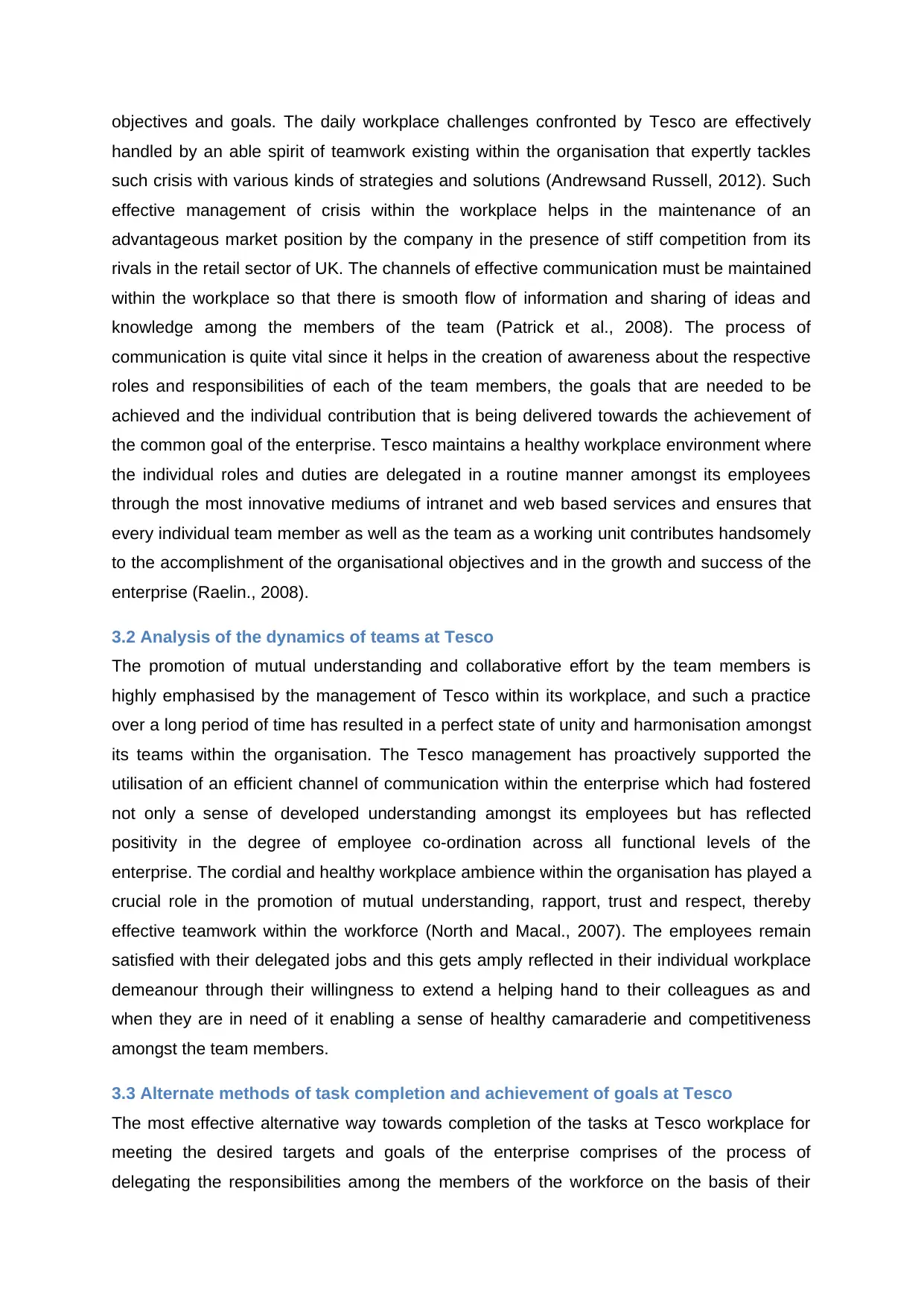
objectives and goals. The daily workplace challenges confronted by Tesco are effectively
handled by an able spirit of teamwork existing within the organisation that expertly tackles
such crisis with various kinds of strategies and solutions (Andrewsand Russell, 2012). Such
effective management of crisis within the workplace helps in the maintenance of an
advantageous market position by the company in the presence of stiff competition from its
rivals in the retail sector of UK. The channels of effective communication must be maintained
within the workplace so that there is smooth flow of information and sharing of ideas and
knowledge among the members of the team (Patrick et al., 2008). The process of
communication is quite vital since it helps in the creation of awareness about the respective
roles and responsibilities of each of the team members, the goals that are needed to be
achieved and the individual contribution that is being delivered towards the achievement of
the common goal of the enterprise. Tesco maintains a healthy workplace environment where
the individual roles and duties are delegated in a routine manner amongst its employees
through the most innovative mediums of intranet and web based services and ensures that
every individual team member as well as the team as a working unit contributes handsomely
to the accomplishment of the organisational objectives and in the growth and success of the
enterprise (Raelin., 2008).
3.2 Analysis of the dynamics of teams at Tesco
The promotion of mutual understanding and collaborative effort by the team members is
highly emphasised by the management of Tesco within its workplace, and such a practice
over a long period of time has resulted in a perfect state of unity and harmonisation amongst
its teams within the organisation. The Tesco management has proactively supported the
utilisation of an efficient channel of communication within the enterprise which had fostered
not only a sense of developed understanding amongst its employees but has reflected
positivity in the degree of employee co-ordination across all functional levels of the
enterprise. The cordial and healthy workplace ambience within the organisation has played a
crucial role in the promotion of mutual understanding, rapport, trust and respect, thereby
effective teamwork within the workforce (North and Macal., 2007). The employees remain
satisfied with their delegated jobs and this gets amply reflected in their individual workplace
demeanour through their willingness to extend a helping hand to their colleagues as and
when they are in need of it enabling a sense of healthy camaraderie and competitiveness
amongst the team members.
3.3 Alternate methods of task completion and achievement of goals at Tesco
The most effective alternative way towards completion of the tasks at Tesco workplace for
meeting the desired targets and goals of the enterprise comprises of the process of
delegating the responsibilities among the members of the workforce on the basis of their
handled by an able spirit of teamwork existing within the organisation that expertly tackles
such crisis with various kinds of strategies and solutions (Andrewsand Russell, 2012). Such
effective management of crisis within the workplace helps in the maintenance of an
advantageous market position by the company in the presence of stiff competition from its
rivals in the retail sector of UK. The channels of effective communication must be maintained
within the workplace so that there is smooth flow of information and sharing of ideas and
knowledge among the members of the team (Patrick et al., 2008). The process of
communication is quite vital since it helps in the creation of awareness about the respective
roles and responsibilities of each of the team members, the goals that are needed to be
achieved and the individual contribution that is being delivered towards the achievement of
the common goal of the enterprise. Tesco maintains a healthy workplace environment where
the individual roles and duties are delegated in a routine manner amongst its employees
through the most innovative mediums of intranet and web based services and ensures that
every individual team member as well as the team as a working unit contributes handsomely
to the accomplishment of the organisational objectives and in the growth and success of the
enterprise (Raelin., 2008).
3.2 Analysis of the dynamics of teams at Tesco
The promotion of mutual understanding and collaborative effort by the team members is
highly emphasised by the management of Tesco within its workplace, and such a practice
over a long period of time has resulted in a perfect state of unity and harmonisation amongst
its teams within the organisation. The Tesco management has proactively supported the
utilisation of an efficient channel of communication within the enterprise which had fostered
not only a sense of developed understanding amongst its employees but has reflected
positivity in the degree of employee co-ordination across all functional levels of the
enterprise. The cordial and healthy workplace ambience within the organisation has played a
crucial role in the promotion of mutual understanding, rapport, trust and respect, thereby
effective teamwork within the workforce (North and Macal., 2007). The employees remain
satisfied with their delegated jobs and this gets amply reflected in their individual workplace
demeanour through their willingness to extend a helping hand to their colleagues as and
when they are in need of it enabling a sense of healthy camaraderie and competitiveness
amongst the team members.
3.3 Alternate methods of task completion and achievement of goals at Tesco
The most effective alternative way towards completion of the tasks at Tesco workplace for
meeting the desired targets and goals of the enterprise comprises of the process of
delegating the responsibilities among the members of the workforce on the basis of their
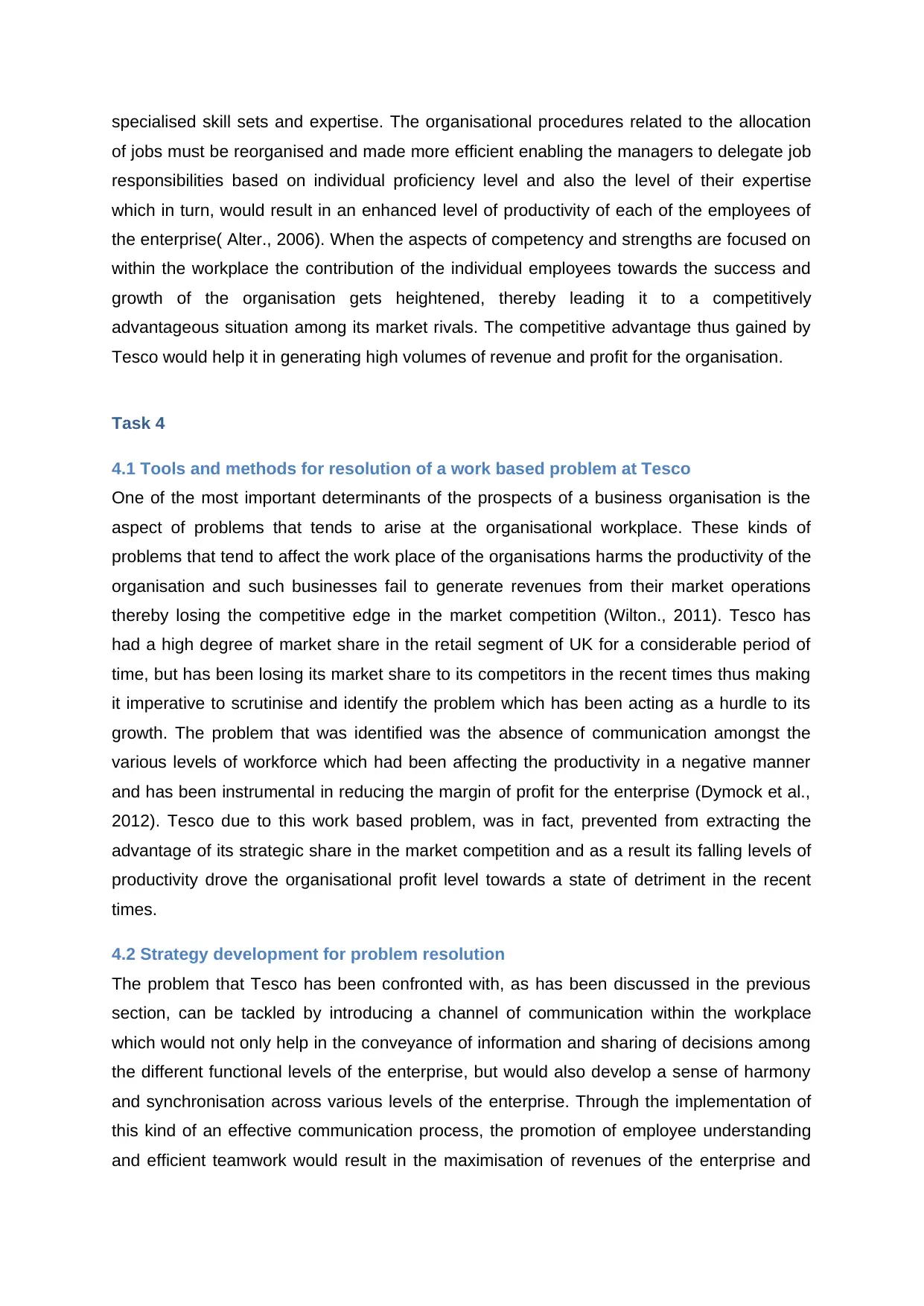
specialised skill sets and expertise. The organisational procedures related to the allocation
of jobs must be reorganised and made more efficient enabling the managers to delegate job
responsibilities based on individual proficiency level and also the level of their expertise
which in turn, would result in an enhanced level of productivity of each of the employees of
the enterprise( Alter., 2006). When the aspects of competency and strengths are focused on
within the workplace the contribution of the individual employees towards the success and
growth of the organisation gets heightened, thereby leading it to a competitively
advantageous situation among its market rivals. The competitive advantage thus gained by
Tesco would help it in generating high volumes of revenue and profit for the organisation.
Task 4
4.1 Tools and methods for resolution of a work based problem at Tesco
One of the most important determinants of the prospects of a business organisation is the
aspect of problems that tends to arise at the organisational workplace. These kinds of
problems that tend to affect the work place of the organisations harms the productivity of the
organisation and such businesses fail to generate revenues from their market operations
thereby losing the competitive edge in the market competition (Wilton., 2011). Tesco has
had a high degree of market share in the retail segment of UK for a considerable period of
time, but has been losing its market share to its competitors in the recent times thus making
it imperative to scrutinise and identify the problem which has been acting as a hurdle to its
growth. The problem that was identified was the absence of communication amongst the
various levels of workforce which had been affecting the productivity in a negative manner
and has been instrumental in reducing the margin of profit for the enterprise (Dymock et al.,
2012). Tesco due to this work based problem, was in fact, prevented from extracting the
advantage of its strategic share in the market competition and as a result its falling levels of
productivity drove the organisational profit level towards a state of detriment in the recent
times.
4.2 Strategy development for problem resolution
The problem that Tesco has been confronted with, as has been discussed in the previous
section, can be tackled by introducing a channel of communication within the workplace
which would not only help in the conveyance of information and sharing of decisions among
the different functional levels of the enterprise, but would also develop a sense of harmony
and synchronisation across various levels of the enterprise. Through the implementation of
this kind of an effective communication process, the promotion of employee understanding
and efficient teamwork would result in the maximisation of revenues of the enterprise and
of jobs must be reorganised and made more efficient enabling the managers to delegate job
responsibilities based on individual proficiency level and also the level of their expertise
which in turn, would result in an enhanced level of productivity of each of the employees of
the enterprise( Alter., 2006). When the aspects of competency and strengths are focused on
within the workplace the contribution of the individual employees towards the success and
growth of the organisation gets heightened, thereby leading it to a competitively
advantageous situation among its market rivals. The competitive advantage thus gained by
Tesco would help it in generating high volumes of revenue and profit for the organisation.
Task 4
4.1 Tools and methods for resolution of a work based problem at Tesco
One of the most important determinants of the prospects of a business organisation is the
aspect of problems that tends to arise at the organisational workplace. These kinds of
problems that tend to affect the work place of the organisations harms the productivity of the
organisation and such businesses fail to generate revenues from their market operations
thereby losing the competitive edge in the market competition (Wilton., 2011). Tesco has
had a high degree of market share in the retail segment of UK for a considerable period of
time, but has been losing its market share to its competitors in the recent times thus making
it imperative to scrutinise and identify the problem which has been acting as a hurdle to its
growth. The problem that was identified was the absence of communication amongst the
various levels of workforce which had been affecting the productivity in a negative manner
and has been instrumental in reducing the margin of profit for the enterprise (Dymock et al.,
2012). Tesco due to this work based problem, was in fact, prevented from extracting the
advantage of its strategic share in the market competition and as a result its falling levels of
productivity drove the organisational profit level towards a state of detriment in the recent
times.
4.2 Strategy development for problem resolution
The problem that Tesco has been confronted with, as has been discussed in the previous
section, can be tackled by introducing a channel of communication within the workplace
which would not only help in the conveyance of information and sharing of decisions among
the different functional levels of the enterprise, but would also develop a sense of harmony
and synchronisation across various levels of the enterprise. Through the implementation of
this kind of an effective communication process, the promotion of employee understanding
and efficient teamwork would result in the maximisation of revenues of the enterprise and
⊘ This is a preview!⊘
Do you want full access?
Subscribe today to unlock all pages.

Trusted by 1+ million students worldwide
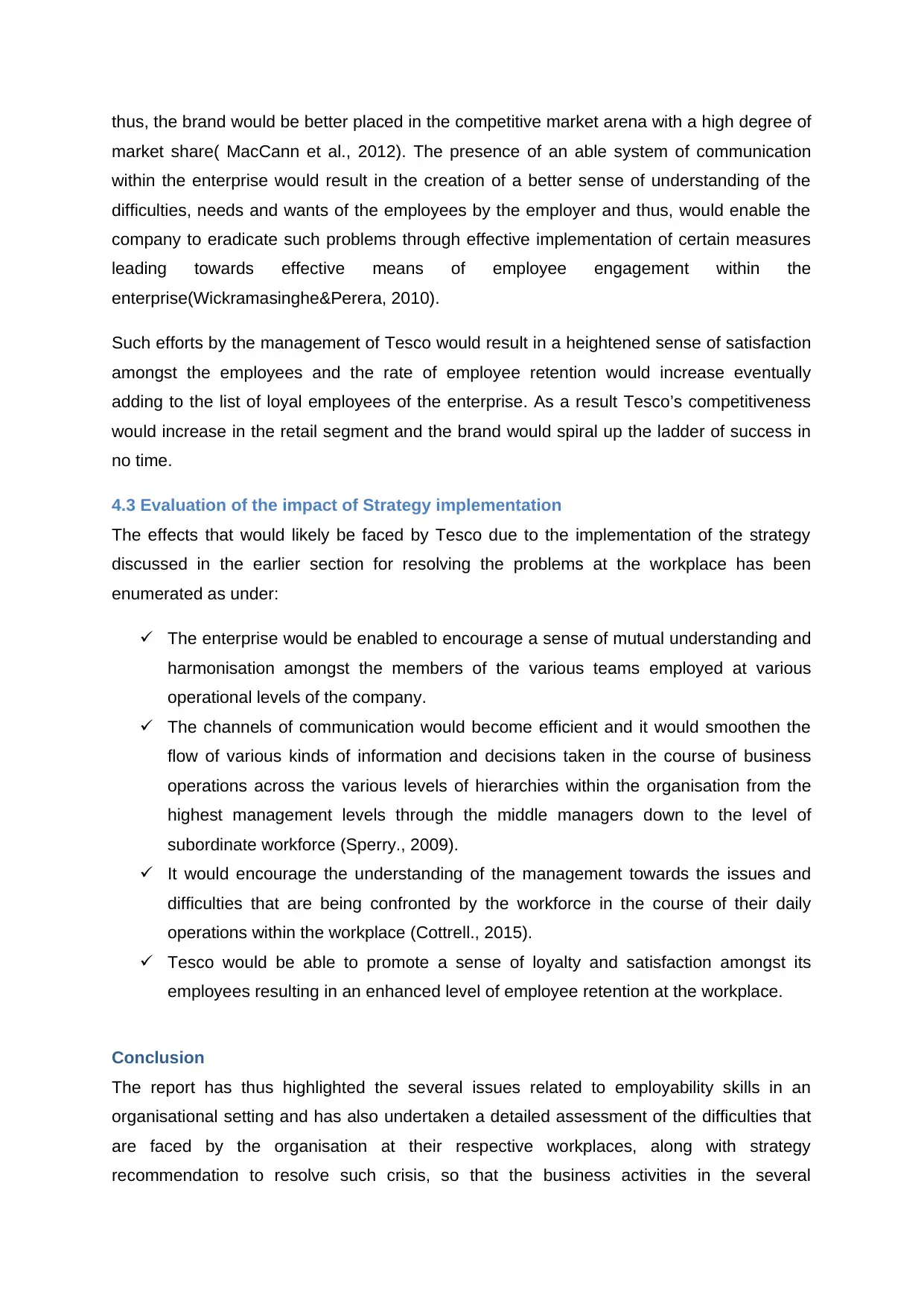
thus, the brand would be better placed in the competitive market arena with a high degree of
market share( MacCann et al., 2012). The presence of an able system of communication
within the enterprise would result in the creation of a better sense of understanding of the
difficulties, needs and wants of the employees by the employer and thus, would enable the
company to eradicate such problems through effective implementation of certain measures
leading towards effective means of employee engagement within the
enterprise(Wickramasinghe&Perera, 2010).
Such efforts by the management of Tesco would result in a heightened sense of satisfaction
amongst the employees and the rate of employee retention would increase eventually
adding to the list of loyal employees of the enterprise. As a result Tesco’s competitiveness
would increase in the retail segment and the brand would spiral up the ladder of success in
no time.
4.3 Evaluation of the impact of Strategy implementation
The effects that would likely be faced by Tesco due to the implementation of the strategy
discussed in the earlier section for resolving the problems at the workplace has been
enumerated as under:
The enterprise would be enabled to encourage a sense of mutual understanding and
harmonisation amongst the members of the various teams employed at various
operational levels of the company.
The channels of communication would become efficient and it would smoothen the
flow of various kinds of information and decisions taken in the course of business
operations across the various levels of hierarchies within the organisation from the
highest management levels through the middle managers down to the level of
subordinate workforce (Sperry., 2009).
It would encourage the understanding of the management towards the issues and
difficulties that are being confronted by the workforce in the course of their daily
operations within the workplace (Cottrell., 2015).
Tesco would be able to promote a sense of loyalty and satisfaction amongst its
employees resulting in an enhanced level of employee retention at the workplace.
Conclusion
The report has thus highlighted the several issues related to employability skills in an
organisational setting and has also undertaken a detailed assessment of the difficulties that
are faced by the organisation at their respective workplaces, along with strategy
recommendation to resolve such crisis, so that the business activities in the several
market share( MacCann et al., 2012). The presence of an able system of communication
within the enterprise would result in the creation of a better sense of understanding of the
difficulties, needs and wants of the employees by the employer and thus, would enable the
company to eradicate such problems through effective implementation of certain measures
leading towards effective means of employee engagement within the
enterprise(Wickramasinghe&Perera, 2010).
Such efforts by the management of Tesco would result in a heightened sense of satisfaction
amongst the employees and the rate of employee retention would increase eventually
adding to the list of loyal employees of the enterprise. As a result Tesco’s competitiveness
would increase in the retail segment and the brand would spiral up the ladder of success in
no time.
4.3 Evaluation of the impact of Strategy implementation
The effects that would likely be faced by Tesco due to the implementation of the strategy
discussed in the earlier section for resolving the problems at the workplace has been
enumerated as under:
The enterprise would be enabled to encourage a sense of mutual understanding and
harmonisation amongst the members of the various teams employed at various
operational levels of the company.
The channels of communication would become efficient and it would smoothen the
flow of various kinds of information and decisions taken in the course of business
operations across the various levels of hierarchies within the organisation from the
highest management levels through the middle managers down to the level of
subordinate workforce (Sperry., 2009).
It would encourage the understanding of the management towards the issues and
difficulties that are being confronted by the workforce in the course of their daily
operations within the workplace (Cottrell., 2015).
Tesco would be able to promote a sense of loyalty and satisfaction amongst its
employees resulting in an enhanced level of employee retention at the workplace.
Conclusion
The report has thus highlighted the several issues related to employability skills in an
organisational setting and has also undertaken a detailed assessment of the difficulties that
are faced by the organisation at their respective workplaces, along with strategy
recommendation to resolve such crisis, so that the business activities in the several
Paraphrase This Document
Need a fresh take? Get an instant paraphrase of this document with our AI Paraphraser
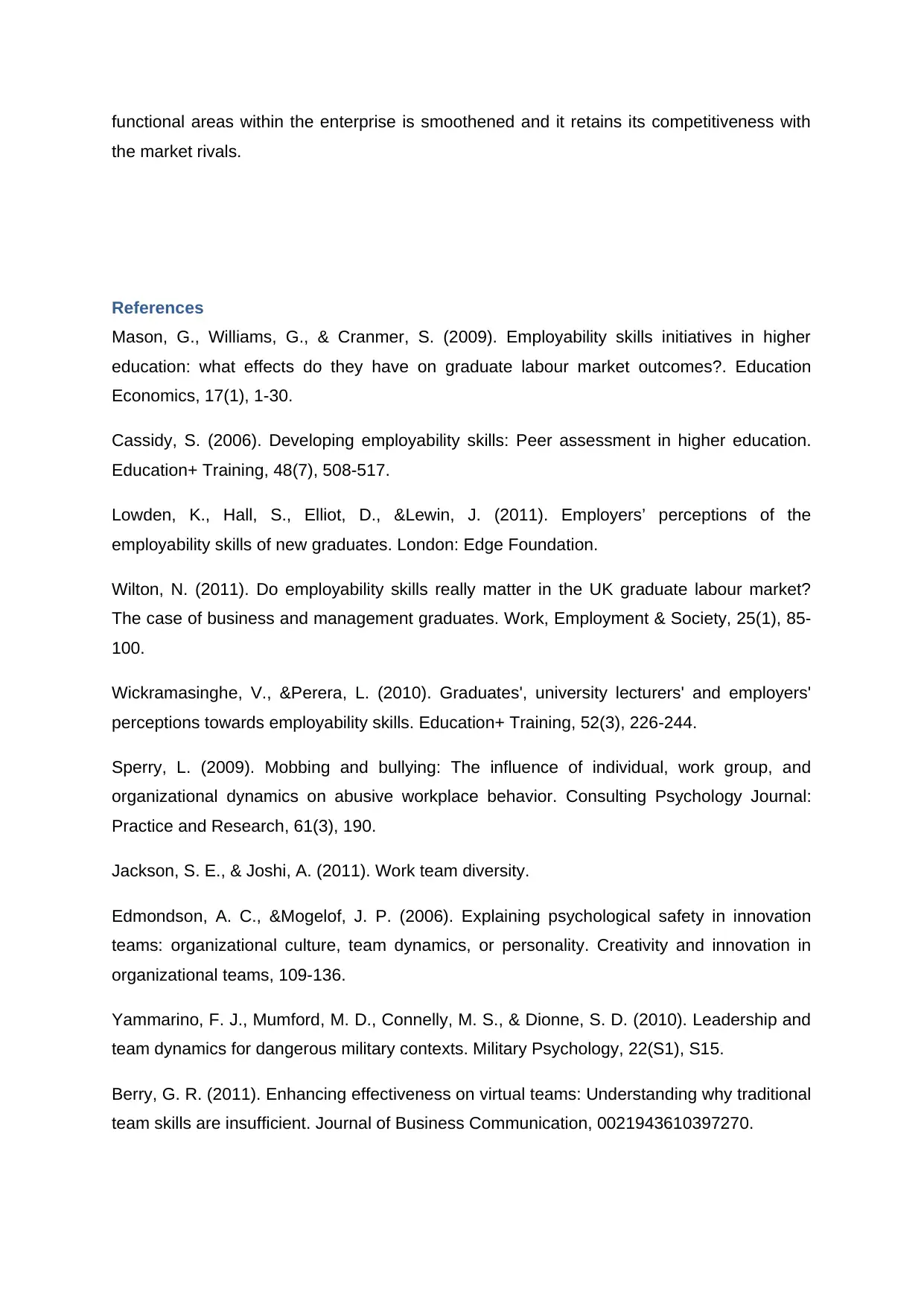
functional areas within the enterprise is smoothened and it retains its competitiveness with
the market rivals.
References
Mason, G., Williams, G., & Cranmer, S. (2009). Employability skills initiatives in higher
education: what effects do they have on graduate labour market outcomes?. Education
Economics, 17(1), 1-30.
Cassidy, S. (2006). Developing employability skills: Peer assessment in higher education.
Education+ Training, 48(7), 508-517.
Lowden, K., Hall, S., Elliot, D., &Lewin, J. (2011). Employers’ perceptions of the
employability skills of new graduates. London: Edge Foundation.
Wilton, N. (2011). Do employability skills really matter in the UK graduate labour market?
The case of business and management graduates. Work, Employment & Society, 25(1), 85-
100.
Wickramasinghe, V., &Perera, L. (2010). Graduates', university lecturers' and employers'
perceptions towards employability skills. Education+ Training, 52(3), 226-244.
Sperry, L. (2009). Mobbing and bullying: The influence of individual, work group, and
organizational dynamics on abusive workplace behavior. Consulting Psychology Journal:
Practice and Research, 61(3), 190.
Jackson, S. E., & Joshi, A. (2011). Work team diversity.
Edmondson, A. C., &Mogelof, J. P. (2006). Explaining psychological safety in innovation
teams: organizational culture, team dynamics, or personality. Creativity and innovation in
organizational teams, 109-136.
Yammarino, F. J., Mumford, M. D., Connelly, M. S., & Dionne, S. D. (2010). Leadership and
team dynamics for dangerous military contexts. Military Psychology, 22(S1), S15.
Berry, G. R. (2011). Enhancing effectiveness on virtual teams: Understanding why traditional
team skills are insufficient. Journal of Business Communication, 0021943610397270.
the market rivals.
References
Mason, G., Williams, G., & Cranmer, S. (2009). Employability skills initiatives in higher
education: what effects do they have on graduate labour market outcomes?. Education
Economics, 17(1), 1-30.
Cassidy, S. (2006). Developing employability skills: Peer assessment in higher education.
Education+ Training, 48(7), 508-517.
Lowden, K., Hall, S., Elliot, D., &Lewin, J. (2011). Employers’ perceptions of the
employability skills of new graduates. London: Edge Foundation.
Wilton, N. (2011). Do employability skills really matter in the UK graduate labour market?
The case of business and management graduates. Work, Employment & Society, 25(1), 85-
100.
Wickramasinghe, V., &Perera, L. (2010). Graduates', university lecturers' and employers'
perceptions towards employability skills. Education+ Training, 52(3), 226-244.
Sperry, L. (2009). Mobbing and bullying: The influence of individual, work group, and
organizational dynamics on abusive workplace behavior. Consulting Psychology Journal:
Practice and Research, 61(3), 190.
Jackson, S. E., & Joshi, A. (2011). Work team diversity.
Edmondson, A. C., &Mogelof, J. P. (2006). Explaining psychological safety in innovation
teams: organizational culture, team dynamics, or personality. Creativity and innovation in
organizational teams, 109-136.
Yammarino, F. J., Mumford, M. D., Connelly, M. S., & Dionne, S. D. (2010). Leadership and
team dynamics for dangerous military contexts. Military Psychology, 22(S1), S15.
Berry, G. R. (2011). Enhancing effectiveness on virtual teams: Understanding why traditional
team skills are insufficient. Journal of Business Communication, 0021943610397270.
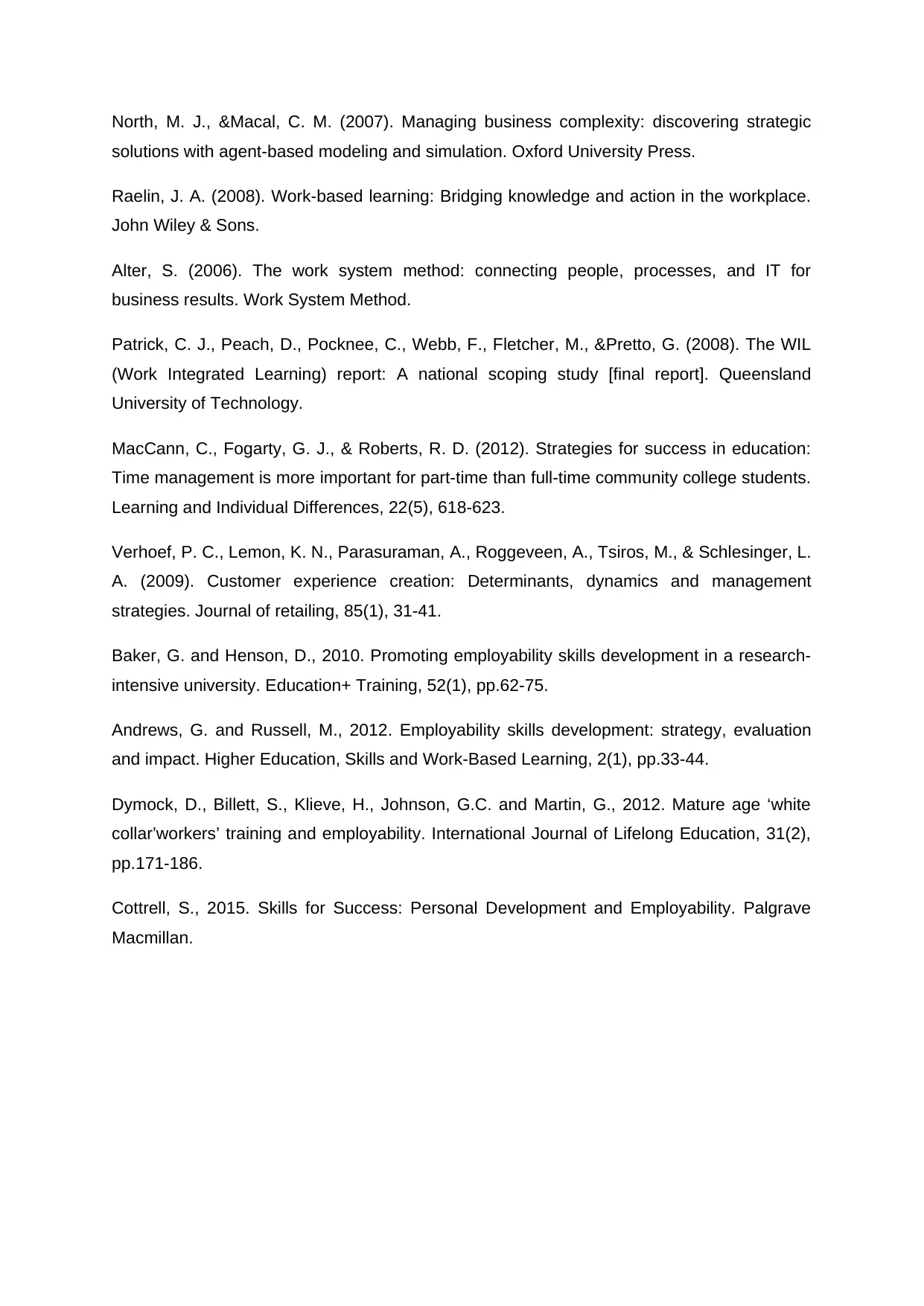
North, M. J., &Macal, C. M. (2007). Managing business complexity: discovering strategic
solutions with agent-based modeling and simulation. Oxford University Press.
Raelin, J. A. (2008). Work-based learning: Bridging knowledge and action in the workplace.
John Wiley & Sons.
Alter, S. (2006). The work system method: connecting people, processes, and IT for
business results. Work System Method.
Patrick, C. J., Peach, D., Pocknee, C., Webb, F., Fletcher, M., &Pretto, G. (2008). The WIL
(Work Integrated Learning) report: A national scoping study [final report]. Queensland
University of Technology.
MacCann, C., Fogarty, G. J., & Roberts, R. D. (2012). Strategies for success in education:
Time management is more important for part-time than full-time community college students.
Learning and Individual Differences, 22(5), 618-623.
Verhoef, P. C., Lemon, K. N., Parasuraman, A., Roggeveen, A., Tsiros, M., & Schlesinger, L.
A. (2009). Customer experience creation: Determinants, dynamics and management
strategies. Journal of retailing, 85(1), 31-41.
Baker, G. and Henson, D., 2010. Promoting employability skills development in a research-
intensive university. Education+ Training, 52(1), pp.62-75.
Andrews, G. and Russell, M., 2012. Employability skills development: strategy, evaluation
and impact. Higher Education, Skills and Work-Based Learning, 2(1), pp.33-44.
Dymock, D., Billett, S., Klieve, H., Johnson, G.C. and Martin, G., 2012. Mature age ‘white
collar’workers’ training and employability. International Journal of Lifelong Education, 31(2),
pp.171-186.
Cottrell, S., 2015. Skills for Success: Personal Development and Employability. Palgrave
Macmillan.
solutions with agent-based modeling and simulation. Oxford University Press.
Raelin, J. A. (2008). Work-based learning: Bridging knowledge and action in the workplace.
John Wiley & Sons.
Alter, S. (2006). The work system method: connecting people, processes, and IT for
business results. Work System Method.
Patrick, C. J., Peach, D., Pocknee, C., Webb, F., Fletcher, M., &Pretto, G. (2008). The WIL
(Work Integrated Learning) report: A national scoping study [final report]. Queensland
University of Technology.
MacCann, C., Fogarty, G. J., & Roberts, R. D. (2012). Strategies for success in education:
Time management is more important for part-time than full-time community college students.
Learning and Individual Differences, 22(5), 618-623.
Verhoef, P. C., Lemon, K. N., Parasuraman, A., Roggeveen, A., Tsiros, M., & Schlesinger, L.
A. (2009). Customer experience creation: Determinants, dynamics and management
strategies. Journal of retailing, 85(1), 31-41.
Baker, G. and Henson, D., 2010. Promoting employability skills development in a research-
intensive university. Education+ Training, 52(1), pp.62-75.
Andrews, G. and Russell, M., 2012. Employability skills development: strategy, evaluation
and impact. Higher Education, Skills and Work-Based Learning, 2(1), pp.33-44.
Dymock, D., Billett, S., Klieve, H., Johnson, G.C. and Martin, G., 2012. Mature age ‘white
collar’workers’ training and employability. International Journal of Lifelong Education, 31(2),
pp.171-186.
Cottrell, S., 2015. Skills for Success: Personal Development and Employability. Palgrave
Macmillan.
⊘ This is a preview!⊘
Do you want full access?
Subscribe today to unlock all pages.

Trusted by 1+ million students worldwide
1 out of 13
Related Documents
Your All-in-One AI-Powered Toolkit for Academic Success.
+13062052269
info@desklib.com
Available 24*7 on WhatsApp / Email
![[object Object]](/_next/static/media/star-bottom.7253800d.svg)
Unlock your academic potential
Copyright © 2020–2025 A2Z Services. All Rights Reserved. Developed and managed by ZUCOL.





